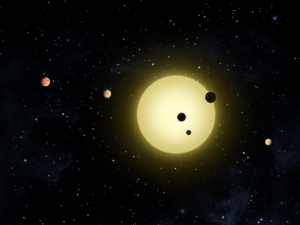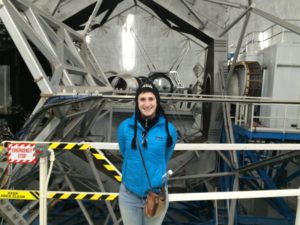Keck Observatory Researchers Discover Pattern in Exoplanet Systems

The Kepler-11 planetary system is one of the multi-planet systems studied by Dr. Weiss and her colleagues. Credit: NASA/T. Pyle.
New research using W.M. Keck Observatory on Maunakea has revealed consistent patterns regarding the shape and orbit of a group of exoplanets orbiting the same star.
An international research team led by Université de Montréal astrophysicist Lauren Weiss discovered the pattern, which indicates that most planetary systems might have different formation histories than our own. The study was published in The Astronomical Journal, revealing the team’s work on 909 planets belonging to 355 multi-planet systems.
Thousands of exoplanets have been discovered since first they were seen in 1992, largely through observations made using NASA’s Kepler Telescope. Dr. Weiss is part of the California Kepler Survey team, which used Keck Observatory to gather high-resolution images of 1305 stars hosting 2025 exoplanets originally discovered by Kepler.
Through the image data, Weiss and her team made precise measurements indicating the size of the stars and their orbiting planets. The team discovered that exoplanets tend to be the same size as their closest neighbors and have a regular orbital spacing.
“The planets in a system tend to be the same size and regularly spaced, like peas in a pod,” said Weiss. “These patterns would not occur if the planet sizes or spacing were drawn at random.”
The findings indicate that most planetary systems may have formed differently than our own. The classical theory of planet formation says that planets form in the protoplanetary disk that surrounds a newly formed star. The planets might form in compact configurations with similar sizes and a regular orbital spacing, resulting in the type of exoplanet patterns observed by Weiss’ team.
In our own solar system, the inner planets have unusually large spacing and diverse sizes. Evidence suggests that Jupiter and Saturn disrupted our system’s early structure, resulting in the four widely-spaced terrestrial planets that are present today. The appearance of most systems containing planets with similar sizes and regularly spaced orbits suggests they have been mostly undisturbed since formation.

Université de Montréal astrophysicist Lauren Weiss visiting Keck Observatory where she conducts observations of planetary systems discovered by the Kepler Telescope. Credit: Lauren Weiss.
Weiss and her team are conducting a new study to test this theory by using Keck Observatory to search for Jupiter-like exoplanets around Kepler systems. They hope to test how the presence or absence of Jupiter-like planets at large orbital distances relates to patterns in the inner planetary systems.
Regardless of their outer populations, the similarity of planets in the inner regions of extrasolar systems requires an explanation. If the deciding factor for planet sizes can be identified, it may help researchers find out which stars are likely to have planets that could support life.













